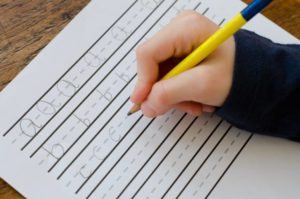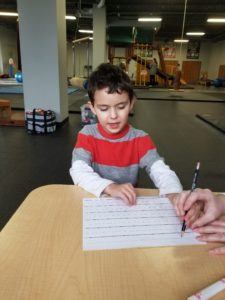Handwriting
After reading Prewriting Tips to Grow On and working on these skills with your child, you should be on the right track to begin handwriting letters and numbers with your child.
1. By 5, your child should begin writing numbers 1-5 and capital letters of his/her first name.
At first, give your child opportunities to trace the capital letters of his/her first name. Once they have mastered this and stay on the lines, they are able to begin writing the letters with a visual model. Focus on learning the appropriate formation of each letter, beginning all letters at the top rather than the bottom. Learning how to form letters correctly from the beginning helps them succeed later. Once your child’s formation of letters is appropriate, work on writing letters independently, without a visual model. When your child learns to write his/her name, s/he is ready to learn the rest of the alphabet.
2. By 5.5, your child should be able to write numbers 1-10 and all capital letters.
Start with capital letters A-M. Begin tracing, then writing with a visual model, and move onto writing independently. Then focus on N-Z following the same sequence. Lastly, put it all together, writing letters A-Z independently.
3. By around 6.5, your child should be able to write all lower case letters.
Follow the same sequence with lower case letters as you did with upper case letters. Lower case letters can also be divided into 3 different categories (tall, diver, and other letters) to teach.
Tall letters: b, d, f, h, k, l, t
Diver letters: g, j, p, q, y
If your child is having difficulty with letter formation, try making starting dots so your child knows where to begin each letter. Also writing in different mediums such as finger paint, sand, shaving cream, playdoh, chalk, and dry erase markers can help children learn how to form letters. Writing in different tactile mediums has been proven to help children learn to write.
After your child has mastered forming capital and lower case letters, it is now time to work on line alignment and sizing. Using horizontal three lined paper (ADD picture) with bold/colored top and bottom lines can assist with line alignment and sizing. Additionally, highlighting these boarders can help. Highlighting the space below the dotted line can help with alignment of lower case letters.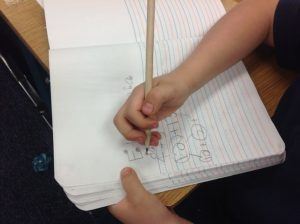
It is now time to move onto writing words and sentences. Make sure letters stay formed and aligned correctly when completing these tasks; sometimes when children begin to write words their formation and alignment decrease. You will now also have to focus on spacing letters within words and spacing between words. The best way to space between words is to use your child’s finger as a space marker.
Again, if you are having concerns or if you child is not progressing like you think s/he should, please do not hesitate to contact ABC Pediatric Therapy and specifically ask for an occupational therapist for more ideas geared towards your specific needs and if you have any additional questions or would like a free screening. Visit our website at www.abcpediatrictherapy.com to find the location nearest you.
Read More1. By a young age, encourage your child to color and explore using paper and crayons as this is an integral part of your child’s prewriting and fine motor development. Continue working on purposeful scribbling, coloring in large/small shapes, drawing (specifically people), and using your child’s creativity throughout his/her childhood.
2. By 2 years old, your child should begin grasping writing utensils in palm and imitating vertical lines.
3. By 2.5 years old, your child should be able to grasp a pencil with thumb and fingers instead of a fist and begin drawing horizontal lines.
4. By 3 years old, your child should begin drawing circles stopping within ½” of the endpoint and making crosses (+).
5. By 3.5 years old, your child should begin drawing X’s.
6. By 4 years of age, your child should begin having a static tripod grasp (grasp using 3 fingers but limited movement within fingers/wrist).
7. By 4.5 years of age, your child should begin to draw squares.
8. By 5, your child should begin drawing triangles and writing numbers 1-5 and capital letters of his/her first name.
9. By 5.5, your child should be able to write numbers 1-10 and all capital letters.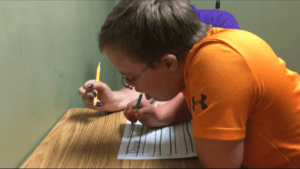
10. By around 6.5, your child should be able to write all lower case letters and have developed a dynamic tripod functional grasp.
If by 4, your child is demonstrating difficulty with holding a writing utensil (pencil, crayons, markers) with 3 fingers and maintaining a functional grasp, it is beneficial to use broken crayon pieces or color/write on a vertical surface as these two activities encourage use of a functional grasp.
Additionally, if your child is still demonstrating difficulty, there are hand strengthening activities you can complete to work on strengthening the specific muscles needed to hold/maintain a functional grasp:
1. Use tweezers to pick up small objects
2. Play with playdoh
3. Use thera-putty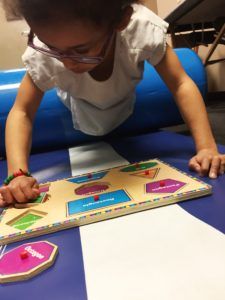
4. Engage with interlocking construction toys such as tinker toys or bristle blocks
5. Encourage water play with spray bottles, water guns, squirt toys, sponges, etc.
6. Clothes pin games
7. Hole punch activities
8. Squeeze toys and activities such as using glue
9. Weight bearing activities such as completing activities in prone (on stomach), wheelbarrow walking, animal walks, etc.
**Pencil grips should be used a last resort when teaching a child to hold a writing utensil as this hinders the development of functional grasp.
If you are having concerns or if you child is not progressing like you think s/he should, please do not hesitate to contact ABC Pediatric Therapy and specifically ask for an occupational therapist for more ideas geared towards your specific needs and if you have any additional questions or would like a free screening. Visit our website at www.abcpediatrictherapy.com to find the location nearest you.
Read More Skip to content
Skip to content
